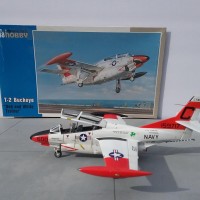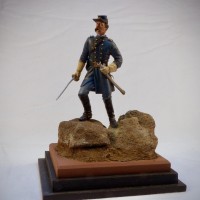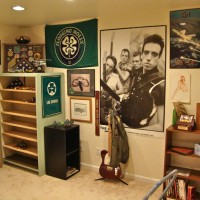Invasion Stripes / Flight 19 P-51B Mustang Viscous Virgie, The Flying Scott
This article is part of a series:
- Invasion Stripes / Flight 19 "FJB" 164 Squadron RAF Hawker Typhoon Mk-1b, Revell 1/32 car door converted to a bubble top.
- Invasion Stripes / Flight 19 Bristol Beaufighter TF Mk X 236 Squadron RAF, Tamiya 1/48
- Invasion Stripes / Flight 19, 1/48 Tamiya Republic P-47D-28RA Thunderbolt "Eileen"
- Invasion Stripes / Flight 19 P-51B Mustang Viscous Virgie, The Flying Scott
This is the old 1/48 scale Tamiya P-51B Mustang... or is it ?
It also happens to the the VERY FIRST razorback Mustang I have built in about 20 years. With those being the Accurate Miniatures kits which were pretty nice. Say it isn't so...
Eduard has recently released the ultimate in the 1/48 scale P-51B "Razorback" model arena. This particular plane you see before you, has the markings for one of the planes you can build if you have the Royal Edition kits. These fabulous Eduard kits contain enough parts to build two Mustangs, plus it also gives you a bunch of extra parts for the spares bin.
I built this plane as a part of this little group of close friends, and also as a tribute to my Grandmother. Her first name was Virginia. If you knew her, you would understand why she may have been called "Viscous" at one time or another. She didn't put up with anything that was out of line... from ANYONE ! Believe me, I found this out the hard way at a very early age.
You didn't mess with Granny... and you better "toe the line" or else.
Sadly she is gone now, and has been for many years. Even though she had a mean streak in her, she still had a heart of gold, and there are times when I think about her... She was a tough woman. She raised my Dad during the Great Depression, and she never missed a single day of work throughout her entire life. Ever... not one day.
So she did her part for America at a time when it was so desperately needed.
I think she had a personal connection there, because she had two brothers serving in the US Army, both serving in the Infantry.
One brother named Fred, was at the Schofield barracks in Hawaii during the attack on Pearl Harbor. He had just left the mess hall after eating breakfast when his barracks was bombed. He didnt get a scratch, but he lost some friends that horrible day, and some of his personal belongings.. He lived through this and survived the War, but never talked too much about it.
He didn't like the Japanese, and that I can tell you for a fact.
Sadly her other brother John was killed in a car accident while home on leave after serving in North Africa and Italy. The family legend has it that he and some of his buddies were "blowing off some steam" and having a good time when the car they were in rolled down the side of the mountain. John was the only fatality that night.
Now on to the aircraft... the incredible P-51 Mustang.
Most of this information was copied from Wikipedia.
352nd Fighter Group
The 352nd Fighter Group was a unit of the Eighth Air Force that was located in the European Theater of Operations during World War II. The unit served as bomber escort, counter-air patrols, and attacking ground targets. It initially flew P-47 Thunderbolt aircraft before converting to P-51 Mustang in April 1944. The group was located at RAF Bodney in England for the majority of its service and were nicknamed the Blue-nosed Bastards of Bodney due to the distinctive blue of the nose and upper cowl of the P-51 Mustangs of the group.
Activation and training:
The 352nd Fighter Group was constituted on 29 September 1942 and activated on 1 October 1942 with Lt. Col. Edwin M. Ramage in command. The unit served in the United States as part of the air defense force while training with P-47 Thunderbolt aircraft. The 352nd squadrons were the 328th the 486th and the 487th Fighter Squadrons.
The 352nd was stationed at Mitchel Field in New York in October 1942 and then moved to Bradley Field in Connecticut later that month. In November 1942, the group moved to Westover Field, Massachusetts, and then to Trumbull Field, Connecticut in January 1943. They moved to Republic Field, New York March–June 1943 before moving to England in June and July 1943.
The group was assigned to I Fighter Command from October 1942 – June 1943 and attached to the New York Fighter Wing in October–November 1942 and March–June 1943 and to the Boston Fighter Wing, November–March 1943.
European theatre of World War II
RAF Bodney
The 352nd Fighter Group moved to RAF Bodney in Norfolk England on 5 July 1943 and was assigned to Eighth Air Force, VIII Fighter Command. Col Joseph L. Mason assumed command on 17 May 1943 and held that position for most of the group's time overseas. The group flew bomber escort missions, counter-air patrols, attacks on airfields, trains, vehicles, troops, gun positions, and other targets. The group was assigned to the 67th Fighter Wing in October 1943, attached to the 1st Bombardment Division in September 1944 and further attached to IX Tactical Air Command in December 1944.
The 352nd escorted bombers during the Big Week operation of 20 to 25 February 1944. The goal of Big Week was to lure the Luftwaffe into a battle by attacking the German aircraft industry.
In April 1944, the group converted from P-47 Thunderbolt to P-51 Mustang aircraft.
The 352nd received a Distinguished Unit Citation for performance during an escort mission to Brunswick Germany on 8 May 1944. While escorting bombers to Brunswick, the group fought off an attack by a numerically superior force of German fighters. The group battled enemy planes until they were forced to withdraw and return to its base due to lack of ammunition and fuel.
Invasion of Normandy
The 352nd Fighter Group participated in the invasion of Normandy in June 1944 with missions to strafing the beaches and other positions and dive-bomb enemy communications. In July 1944, the group supported the allied breakthrough in the Battle of Saint-Lô and in September 1944 supported Operation Market Garden in the Netherlands.
Col. James D. Mayden became commanding officer on 17 Nov 1944 and would serve as CO through VE day.
Battle of the Bulge
During the Battle of the Bulge, a detachment of the 352nd was sent to Asch Airfield in Belgium and placed under the control of the Ninth Air Force.
The group received the French Croix de Guerre with Palm for actions on 1 January 1945 during the German Operation Bodenplatte. The goal of Bodenplatte was to gain air superiority during a stagnant stage of the Battle of the Bulge so that the German forces could resume their advance.
On that day, the 487th squadron, John C. Meyer anticipated the attack and had a flight of 12 planes ready to take off when the attack began. As the planes were readying for takeoff, the airfield was attacked by about 50 fighters from Jagdgeschwader 11 and the 487th planes took off under fire. In the ensuing battle, the 352nd shot down almost half the enemy planes without any losses.
Belgium
In February 1945, the remainder of the 352nd moved to Belgium and, with the 361st Fighter Group, became the first fighter groups to move to the European continent. the remainder of the group joined the detachment in Belgium for operations under the control of Eighth AF. The 352nd supported the Operation Varsity airborne assault across the Rhine in March 1945.
The group returned to RAF Bodney in April 1945 and operated there until V-E Day on 8 May.
Post war
The 352nd Fighter Group returned to Camp Kilmer, New Jersey in November 1945. On 24 May 1946, it was redesignated the 113th Fighter Group and allocated to the District of Columbia Air National Guard with the exception of the 328th Fighter Squadron which was allocated to the Virginia National Guard .
Aces
The 352nd Fighter Group had 27 fighter aces.
Major George Preddy,
Col. John C. Meyer,
Lt. Col. William T. Halton,
Capt. John Thornell,
Capt. Donald S. Bryan,
Capt. Glennon T. Moran,
Capt. Raymond H. Littge
Capt. William T. Whisner
Preddy was the leading P-51 ace and commanded the 328th Fighter Squadron of the 352nd.
I'm not going to cover the Mustang. There's already been a lot written about it, and chances are most of you already know about it.
This particular model was built almost right out of the box. I scratch built a seat harness for it, using masking tape and some beading wire. It's not perfect, but neither am I. Neither was Granny.
I also used some Eagle Strike Productions decals for this build, set number IP4810 "Blue Nosed Birds of Bodney".
This particular Mustang was a P-51B-10, serial number 42-106472.
The regular pilot was first assigned to 1st Lieutenant Murdoch Cunningham, from the 486th Fighter Squadron
Later it was passed down to 1st Lieutenant Carlton Furman from the same unit.
352nd FG, 486th FS; fuselage code "PZ-D" named "The Flying Scot II" on the left side of the nose, and "Vicious Virgie JG" on the right.
According to the Eduard instructions, on September 12, 1944, it was written off when it crashed during a landing. Aparently it crashed into Lt. Glenn Wensch. No mention is made about the fate of either pilot.
The instructions then go on to state the 486th Fighter Squadron shot down at total of 114 enemy aircraft confirmed, 5 probable, and another 21 listed as damaged.
I don't know why, but there's something about these Blue nosed Mustangs that draws me... like a moth to a flame.
This particular Mustang also happens to be my very first attempt at spraying the new Mr Color Super Metallic II paints. I can't talk highly enough about them. They are GREAT ! I sprayed on a gloss black base coat, and let it sit up overnight. The next day I went to work using the SM-206 and SM-208 colors. I also used the rapid dry thinner. I was able to mask everything up and change colors in the time it took me to clean the air brush. The paint was sealed with the recommended Mr Clear from a rattle can.
Since the Mustang has a painted wing, and the early versions had fabric covered controls, I wanted to try this new paint in a mix of paint and Bare Metal Foil.
So I used several different shades of foil on the fuselage and tail section. I also used a different color for the exhaust shroud, which was made from stainless steel on the real plane.
The D Day Invasion stripes are painted on. I made sure they were not equal in width, not are they straight. In other words, they are not perfect like we would see on a modern day restoration. Instead, these are painted on to look as if they were done in a hurry.
I have only found one picture of this particular plane. If you look closely at the original photo, you can see how the upper striped areas have been painted over with a lighter color. It is likely a shade of off white or possibly a gray color. You can also see some "Bodney Blue" over spray on the base of the propeller blades. I tried to replicate this feature on my build with the propeller blades. I wanted the model to have a full set of Invasion Stripes, since this is what our little group was building at the time.
It was taken shortly before it was written off in the landing, because the upper surfaces of the stripes were painted over using a light color. This color could have been a white, or an off white / tone down using light gray or possibly even a touch of black mixed in with the white.
When the full wrap around style of stripes were in use, the aircraft letter was moved to the sides of the nose.
I hope you have enjoyed this as much as I have enjoyed building it.
To answer your questions, it is a Tamiya P-51B... It's also my very FIRST tamiya P-51B build.
And you can bet I will be building more of them. The fit is amazing and no filler was needed... anywhere. That's something to think about when you're building a plane with a bare metal finish.
As always,
comments are encouraged.
Thanks for stopping by.










































I agree Louis @lgardner about the Blue Nosed Bastards of Bodney. Some weird attraction.
Robert Paschall (@beauslx)
Thanks buddy ! I am captivated by both the color and the unit. It just looks so perfect on a Mustang.
Agreed, the 352nd blue runs neck and neck with the 4th Fighter Group red for the most iconic decoration on P-51s. Great build. I am going to have to look up some of the Mr. Color Super Metallics.
Russell Jurco (@russjurco)
Thank you. I am very impressed with the Mr Color Super Metallic II line. This is the very first time I used them. I think they look great when used along with bare metal foil. The SM206 and SM208 colors are recommended to use a Gloss Black base but I'm not sure if it is absolutely necessary. I did use their Rapid Dry thinner. It worked exactly as advertised.
Thanks again.
And yet another lovely "stripes" build! Man, you have been a factory!
I can only agree on the above compliments, Louis @lgardner
The way you took all the recent pictures is very nice as well, great colors.
Absolutely brilliant idea getting this Invasion Stripes group landing right on June 6th. Don't know where to begin but your builds and all the others are outstanding. Great photos all around, Louis @lgardner. Now I know why you have been so quiet these last six months.
Another superb result, Louis! Congratulations my friend!
This is a wonderful build, Louis. The subtlety of the work with the different metallics and foil is at another level. I had always preferred mustangs in olive drab before this build. I think you have convinced me otherwise. I really believe the metal finish is one of the toughest to achieve in scale models. Your approach is a reference for others now!
It looks magnificent in the sunshine.
Another blue nosed beauty, Louis. Well done!